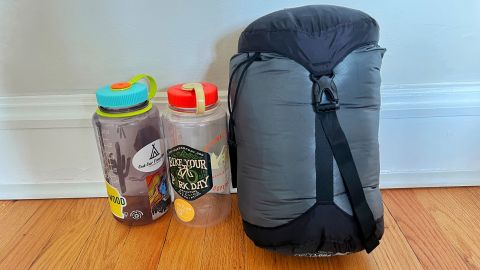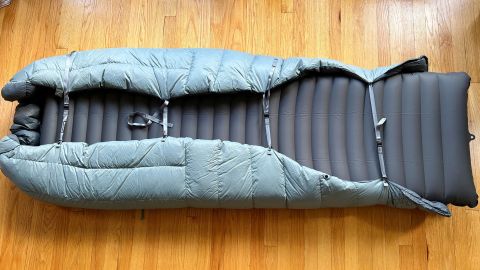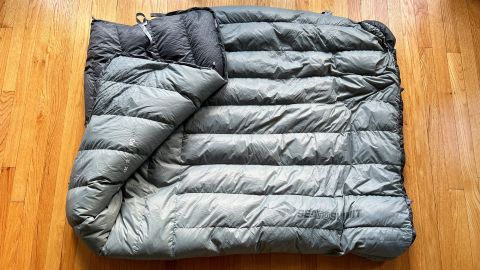
[ad_1]
It’s no secret that sleeping bags are an essential piece of camping gear. Without one, you’ll likely spend the night shivering in your tent once the sun goes down. But have you ever heard of a camping quilt?
Quilts — and no, not the kind sitting on your grandma’s couch — make a great companion for hikers and campers looking for a lightweight sleep system for their outdoor adventures. Unlike a traditional sleeping bag, they’re designed without an underside or hood, which helps cut down on weight and volume.
While most campers opt for a standard rectangle or mummy sleeping bag for their outdoor adventures, camping quilts are most often used by backpackers, thru-hikers and anyone who’s into ultralight camping like hammock campers. They also make a great additional layer on top of a regular sleeping bag on extra-chilly nights.
We tested the Sea to Summit Cinder Down Quilt on a few camping trips this season to see what the hype’s all about. Here’s what we found.
A down quilt that gives you all the warmth without the weight
The Cinder is a super-packable down quilt designed for weight-conscious backpackers or campers who want an extra layer of warmth. Snag this quilt if you want more versatility for how you sleep outside, like an extra layer during the colder seasons, a throw blanket for around the fire or a lightweight option for warm weather camping.
Quilts make all the difference for folks who want to hit the trail with less weight or head to the campground with an extra layer of warmth. Similar to sleeping bags, quilts are filled with either real or synthetic down and are used as a top cover while sleeping or hanging out at home or the campsite.
As an avid car camper myself, an ultralight sleep system isn’t usually something I bring with me to the campground. I’m used to packing heavier-duty and heavier-weight sleeping bags (or extra blankets) in my SUV when I know it’s going to be cold. However, when I heard about the Sea to Summit Cinder Quilt, I knew I had to give it a try.
While pricey, the Sea to Summit Cinder Quilt’s versatility and quality makes it worth the investment. This quilt can be used in a variety of ways and during all seasons: Bring it with you backpacking as a lightweight alternative, throw it on top of your sleeping bag for an added layer of warmth or use it as a blanket while camping in warmer months.
Lightweight and versatile
When you’re headed out on a long thru-hike or multi-day backpacking trip, it’s imperative to consider how much weight is in your pack. The Cinder Quilt’s ultimate use case was intended as a lighter alternative to a full-size sleeping bag for the backcountry. Because the quilt has no backside or hood, it’s much smaller than your average sleeping bag. Sea to Summit insulated this quilt with a super lofty 750+ fill power down, which ensures a “lowest comfort temperature” rating down to 35 degrees Fahrenheit.
It also comes with an included stuff sack that allows you to compress the quilt even more. When compressed in its stuff sack, the quilt is about the same height and width as two Nalgene water bottles and weighs in at just under 1.5 pounds (23.3 ounces).

If you’re not into backpacking but want a warm extra layer to bring to the campground with you, the Cinder is also a great option. This fall, while staying with a group of friends at Kettle Moraine State Forest — Southern Unit, I was thankful to have brought my Cinder Quilt. For mid-October, we had unseasonably cold weather, and the temperatures dropped into the low 30s at night.
To stay protected from the cold, I threw the Cinder Quilt on top of my normal sleeping bag before bed for an extra layer of warmth. Temperatures the first night dropped down to 31 degrees Fahrenheit and the quilt kept me warm all night. Putting the sleeping quilt on top of my regular sleeping bag added up to 10 degrees of additional warmth, since I usually sleep in 40 degrees in my regular bag without feeling chilly. I decided to put the Cinder inside my regular sleeping bag on night two when the temperatures hovered around 36 degrees Fahrenheit and had to take the quilt out because I got too hot eventually.
The Cinder is clearly a great option if you want to supplement the sleep system you already have to be more cold weather-ready. However, it’s more versatile than that. The Cinder Quilt is a fantastic throw blanket around the campfire (or even in your living room), thanks to a set of pouches in the top corners that allowed me to put my hands in and hug the quilt even tighter around my body. Talk about super cozy.
Smart design and features
For such a simple quilt, the Cinder comes with a surprisingly thoughtful design and a smart set of features. Sea to Summit designed this quilt with its own QuiltLock system for a more secure and snug fit around sleeping bags and sleeping pads.

On top of snaps that help secure the Cinder Quilt to any Sea to Summit sleeping bag, it also comes with four removable and adjustable straps that allow you to secure the quilt around the back of any sleeping pad for a more snug fit. The removable straps can also be loosened or tightened depending on how much space you need for your body between the sleeping pad and the top quilt.
At the top and bottom of the quilt is a built-in drawstring that can be pulled tight to cinch together and create a foot box in chilly weather or around your neckline to prevent unwanted drafts. This comes in handy on cooler or windy nights, especially since this quilt does not have a hood.
While the Cinder Quilt is a great option for spring, summer and early fall, come cool weather months, you might want to rethink using this as a stand-alone sleep system. It makes a great additional layer on top of a regular sleeping bag; however, this quilt likely won’t keep you warm in cold weather on its own.
As mentioned, when using this quilt inside of my regular sleeping bag while car camping, I started to get hot — so hot that I started to sweat. The result: My skin started to stick to the inside of my Cinder Quilt. Nylon, polyester and taffeta quilts tend to hold up best for comfort in warm weather, whereas nylon is notoriously known to stick to your skin, especially when sweating.

If you wear this quilt in warmer weather, it’s best to avoid sleeping in your birthday suit. Instead, stick to wearing a T-shirt (or long sleeves if it makes sense) and sleep pants made of a fabric that’s known to wick sweat, such as merino wool or synthetic material like polyester. You can also bring a sleeping bag liner to cozy up in. That way the extra layer will prevent your skin from sticking to your sleeping pad and quilt.
The Cinder Quilt is no small investment. At $249, it’s a hefty price tag for a piece of outdoor gear. That said, the Cinder is on par with, if not more affordable than, similar quilts on the market. (We dive into how it stacks up to the competition below.) Key features that factor into the high price point are the fact that it’s insulated with 100% RDS down, insulated at 750+ fill power and Sea to Summit’s reputation as a brand that designs products that are built to last.
While no two quilts are created exactly alike, they all share a commonality: They make great camping companions because of their versatility, packability and added warmth.
In general, the more expensive the sleeping quilt, the warmer and more compact you can expect it to be. The Cinder is very comparable to competitors on the market in terms of weight, comfort temperature rating and price. However, during my testing, I found the Cinder Quilt to be a very high-performing and reliable quilt for a very fair price.
Similar to the REI Co-op Magma Trail Quilt and Therm-a-Rest Corus Quilt, the Cinder Quilt clocks in at just over 1 pound and each of these bags falls within 5 degrees of each other for lowest comfort temperature rating. The biggest differences come into play when comparing fill power and price point. The REI Magma Trail is the priciest comparable quilt ($329), but it packs down the smallest to a 3-liter volume in its stuff sack. Of the three quilts, the Magma Trail also promises the most warmth. The Therm-a-Rest Corus packs down to a slightly lower volume at 4 liters in its stuff sack and comes in at only a slightly higher price point ($269.95) than the Sea to Summit Cinder Quilt.
Here’s a full breakdown of these three very comparable quilts:
Whether your adventures take you deep into the backcountry, your local state park or a campout in your own backyard, the Cinder Quilt can be a helpful piece of gear to add to your camping checklist. Its versatility to be used as a stand-alone quilt or an extra layer on top of a regular sleeping bag means you have more opportunity to use it after your investment. From its packability to its sustainable design, the Sea to Summit Cinder Down Quilt is a piece of gear I can promise you won’t regret buying.
[ad_2]